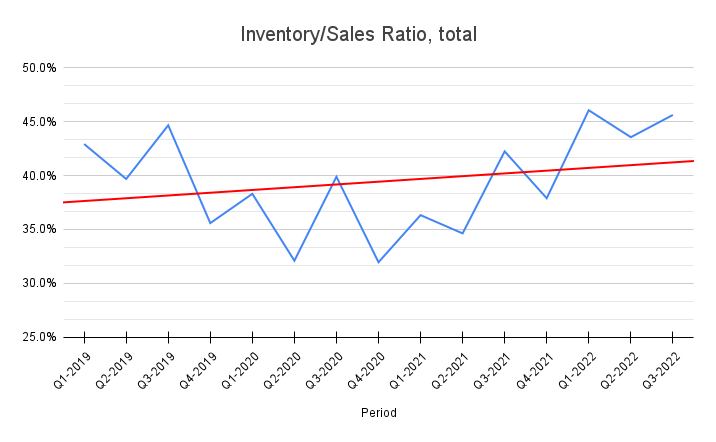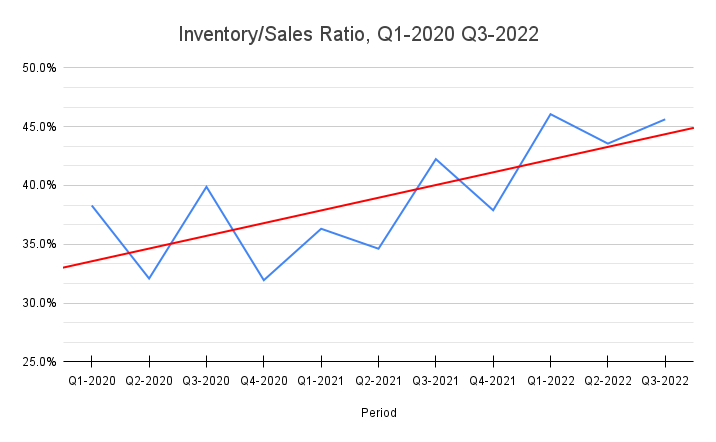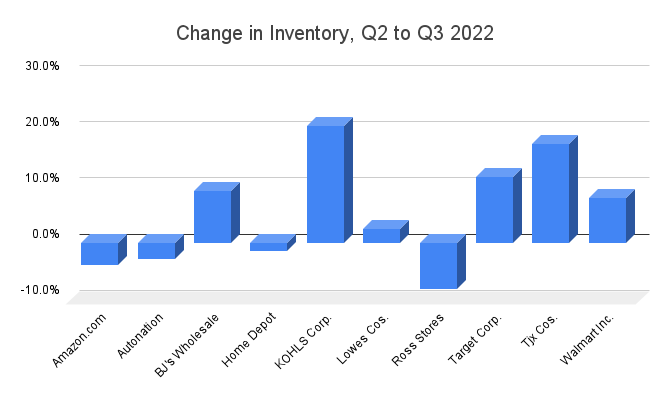Faithful readers of the Calcbench blog might recall that back in May, we wrote a post exploring whether inflation might be about to turn downward. Specifically, we looked at “the bullwhip effect” among large retailers — defined as a rising ratio of inventory to sales, which theoretically would be a harbinger of prices going downward.
Six months later, overall inflation has clearly not gone down, more due to high food, energy, and housing costs than anything else. Still, we wanted to circle back to the 10 large retailers we examined in May, to see whether the bullwhip finally is cracking their backsides.
Answer: yes.
Figure 1, below, shows the ratio of inventory to sales for all 10 of those retailers combined, from the start of 2019 through Q3 2022. You can clearly see how the ratio dropped sharply in 2020 and stayed low into mid-2021, which coincides with when the supply chain went haywire and we saw goods shortages all over the place.

The red trend line, however, is only a gentle upward slope; and recent inventory-to-sales ratios aren’t terribly higher than they were pre-pandemic. For example, the Q2 2022 ratio was 43.6 percent, slightly lower than the 44.7 percent seen in Q3-2019.
That might lull some people into believing the retail sector is just returning to historical norms, and perhaps on longer time horizons that’s true. But for kicks, we ran the same analysis starting from Q1 2020, excluding those pre-pandemic norms. Figure 2, below, is the result.

Wow. Suddenly the trend line looks much steeper, and the quarterly numbers much more grim. No wonder some large retailers have begun their Black Friday sales before Thanksgiving, promising deep discounts all over the place.
Several questions then arise.
- Does this rising ratio indeed presage a bullwhip effect, where prices fall sharply and inflation cools?
- Even if inflation does cool, will those lower temperatures affect only the retail sector, or the economy overall?
- For retail analysts specifically, does this trend suggest that the retail sector will return to pre-pandemic buying habits and financial ratios? Or did the pandemic shift consumer buying habits in some fundamental way, where these inventory-to-sales ratios are alarmingly high?
We don’t know the answers to those questions, but we do have the data to help you answer them.
Finally, for those interested in the 10 specific retailers we studied, Figure 3, below, shows the change in inventory levels for each one from Q2 to Q3 of this year.

The higher the change, the more inventory the retailer has clogging up shelves and warehouses. That could presage price cuts, which could presage lower revenues once firms start reporting Q4 early next year. We’ll see.